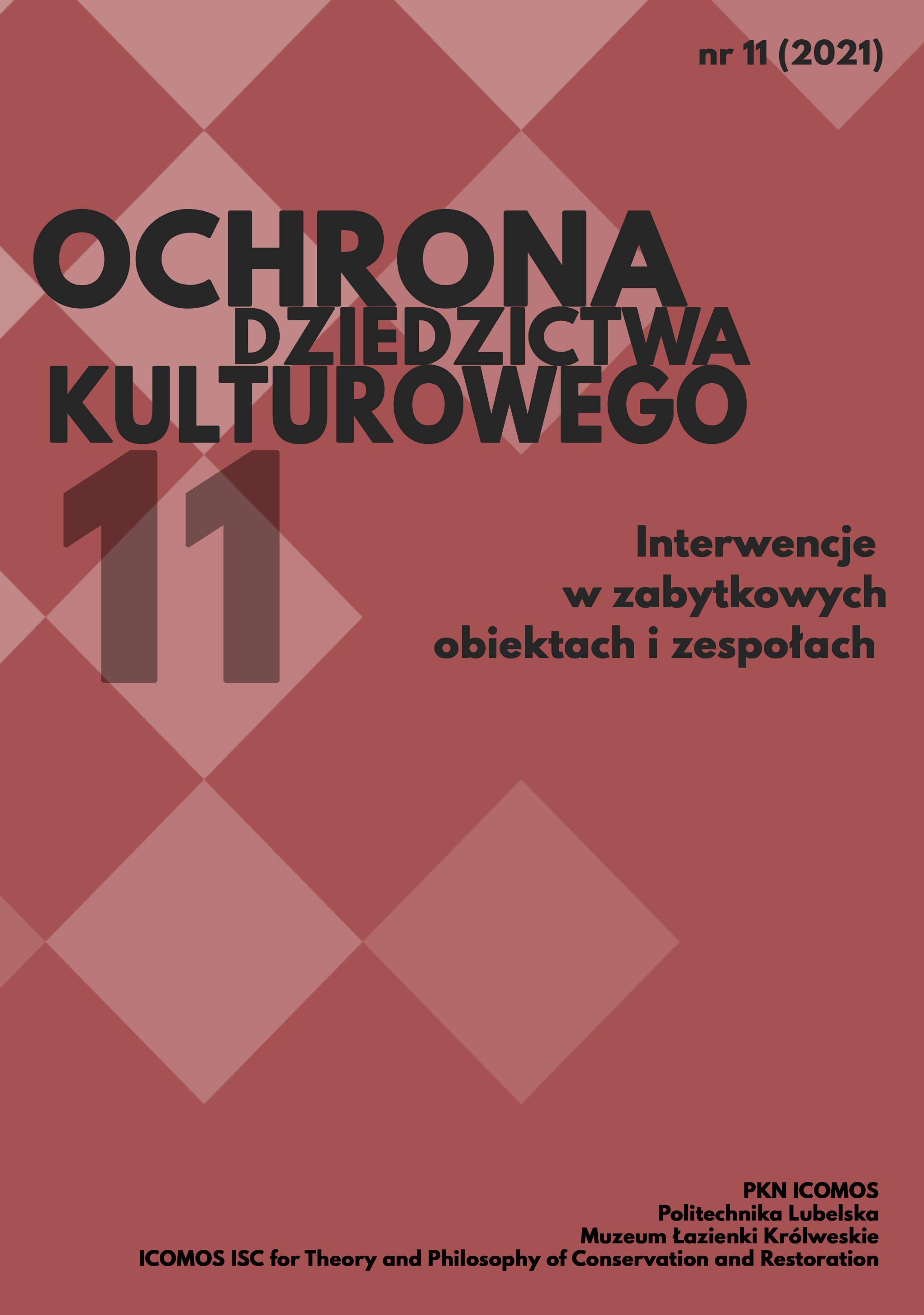Analysis of the Component Values of the Historic Urban Complex – the Basis for Conservation Programs and Plans
Article Sidebar
Open full text
Issue No. 11 (2021)
-
Letting Go: the Limits of Intervention
Grzegorz Bukal1-12
-
Transformation of Historic Buildings – an Attempt at Codification
Piotr Molski13-26
-
Problems of Protection of Historical Industrial Buildings on the Example of the Port and Shipyard Complex in Gdynia
Robert Hirsch, Celina Łozowska27-42
-
New Old Town in Elbląg – Multi-faceted Intervention in a Historic Area
Katarzyna Wiśniewska43-64
-
Urban Conservation in International Charters: From the Athens Charter to the Historic Urban Landscape Recommendation
Antonino Frenda, Marco Valle65-74
-
Integrity versus Intervention Boundaries in Modernist Housing Complexes
Case study of the healt/holiday districts in UstrońBłażej Ciarkowski75-86 -
São Luiz do Paraitinga: The Image of São Paulo State in the 18th Century
Rogério Pereira de Campos, Maria Fernanda Rodrigues, Anibal Costa, Humberto Varum87-105
-
Tenement House "Pod Kruki", Market Square 25, Krakow. The Present of History – the Layering of the Future
Marcin Włodarczyk, Małgorzata Mariola Włodarczyk107-126
-
The Latest Strategic Documents Specifying Changes in the Approach to the Modernization of Monuments in Poland
Katarzyna Pałubska, Katarzyna Zalasińska127-142
-
Parks, Gardens and Other Forms of Composed Greenery – Boundary Conditions for Contemporary Interventions
Dorota Sikora143-160
-
Criteria to Be Met by Contemporary Design Works Transforming the Form and Utility Program of Historic Sacred Architecture in the View of Selected Examples from Europe
Konrad Szumiński161-170
-
Analysis of the Component Values of the Historic Urban Complex – the Basis for Conservation Programs and Plans
Boguslaw Szmygin171-179
-
ICOMOS Heritage Impact Assessment – Application to National Conservation Practice
Marcin Górski181-199
Main Article Content
DOI
Authors
Abstract
The most complex problem in historic preservation is the protection of historic cities. The main problem is the need to combine the conservation requirements (restrictions on transformations) with the growing needs of modernization. The historic city needs to modernize, so conservationist must define the object, form and limits of transformation. It is therefore necessary to develop a methodology that will make it possible to link the historic values of the ensemble with their material representation. This will make it possible to identify the elements to be protected and the elements that can be transformed.
The methodology of determining the material representation of historic values has been shown on the example of the historic center of Krakow inscribed on the UNESCO World Heritage List. The SMART VALUE methodology was used in the development of the Krakow Management Plan. The methodology can be used as a tool to help in the management of different groups of monuments, especially those of significant value (especially those declared as Monuments of History or World Heritage properties).
Keywords:
References
Ashworth G., Paradygmaty i paradoksy planowania przyszłości, [w:] G. Ashworth, Planowanie przyszłości, MCK, Kraków 2015, ss. 21-142.
Bandarin F., van Oers R., The Historic Urban Landscape. Managing Heritage in an Urban Century,Wiley-Blackwell, 2012. DOI: https://doi.org/10.1002/9781119968115
Conservation Turn – Return to Conservation. Tolerance for Change, Limits of Change, Edizioni Polistampa, Firenze 2012.
Council of Europe Framework Convention on the Value of Cultural Heritage for Society (Faro,27.X.2005); http://conventions.coe.int/Treaty/EN/Treaties/Html/199.html
Krawczyk J., Nazwać, żeby ocalić. Klasycy myśli konserwatorskiej wobec reliktów przeszłości, Wydawnictwa Naukowe UMK, Toruń 2020.
Systemy wartościowania dziedzictwa. Stan badań i problemy (praca zbiorowa), PKN ICOMOS, Warszawa Lublin, 2015.
Szmygin B., Atrybuty wyjątkowej uniwersalnej wartości, [w:] Wyjątkowa Uniwersalna Wartość a monitoring Dóbr Światowego Dziedzictwa, PKN ICOMOS, Warszawa 2011, ss. 60-69.
Szmygin B., Fortuna-Marek A., Siwek A., Assessing the Values of Heritage in SV System: the Method and Examples of Use, Lublin 2018.
Szmygin B., Siwek A., Fortuna-Marek A., Model reprezentacji wartości dobra Światowego Dziedzictwa UNESCO dla miasta historycznego, „Ochrona Zabytków”, nr 2/2021, Warszawa 2021 (w druku).
The World Heritage List. What is OUV?, seria “Monuments and Sites”, t.VI, ICOMOS International, Paris, 2008.
Values and Criteria in Heritage Conservation, (praca zbiorowa), Edizioni Palistampa, Firence, 2008.
Wartościowanie zabytków architektury (praca zbiorowa), PKN ICOMOS, Warszawa Lublin, 2013.
Article Details
Abstract views: 290
License

This work is licensed under a Creative Commons Attribution-ShareAlike 4.0 International License.






